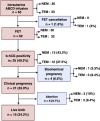Efficacy of intrauterine autologous blood cell derivatives in enhancing endometrial thickness and IVF outcomes for women with recurrent implantation failure: a retrospective cohort study
- PMID: 39235518
- PMCID: PMC11535134
- DOI: 10.1007/s10815-024-03231-5
Efficacy of intrauterine autologous blood cell derivatives in enhancing endometrial thickness and IVF outcomes for women with recurrent implantation failure: a retrospective cohort study
Abstract
Purpose: The purpose of this study was to determine the effects of intrauterine infusion of autologous blood cell derivative (ABCD) on endometrial thickness and pregnancy outcomes in a group of patients who underwent IVF with recurrent implantation failure (RIF) and who had either a normal endometrium or thin endometrium.
Methods: This retrospective study included 63 patients who experienced RIF at the Department of Reproductive Medicine and Surgery, KMC, Manipal, between January 2021 and March 2024 and who received three doses of intrauterine ABCD infusion to prepare the endometrium for frozen embryo transfer (FET).
Results: We enrolled 63 RIF patients, 30 with a normal endometrium (NEM) and 33 with a thin endometrium (TEM). The endometrial thickness (EMT) significantly increased across all the groups. After 3 cycles of intrauterine ABCD infusion, the mean increases in EMT in the NEM and TEM groups were 0.77 mm and 1.36 mm, respectively, which were statistically significant. Among the 62 completed FET cycles, 40.3% were positive for beta-hCG. The clinical pregnancy rate was 33.8% (40% in the NEM group, 28.1% in the TEM group), and the live birth rate was 24.2% (30% in the NEM group, 18.8% in the TEM group). A total of 9.7% of pregnancies had spontaneous miscarriages. Moreover, the EMT did not differ between the pregnant and nonpregnant groups.
Conclusion: Intrauterine ABCD infusion improves the pregnancy outcomes of patients with RIF, regardless of the EMT. The results of this study revealed that endometrial receptivity improved significantly along with the EMT.
Keywords: Autologous blood cell derivatives; Endometrial insufficiency; Normal endometrium; Platelet-rich plasma; Recurrent implantation failure; Thin endometrium.
© 2024. The Author(s).
Conflict of interest statement
The authors declare no competing interests.
Figures


Similar articles
-
Effects of autologous platelet-rich plasma intrauterine perfusion on clinical outcomes in recurrent implantation failure patients with non-thin endometrium undergoing frozen-thawed embryo transfer.Arch Gynecol Obstet. 2025 May;311(5):1423-1433. doi: 10.1007/s00404-025-07983-y. Epub 2025 Mar 19. Arch Gynecol Obstet. 2025. PMID: 40105934 Free PMC article.
-
Angiogenic factor-driven improvement of refractory thin endometrium with autologous platelet-rich plasma intrauterine infusion in frozen embryo transfer cycles.Front Endocrinol (Lausanne). 2024 Sep 3;15:1431453. doi: 10.3389/fendo.2024.1431453. eCollection 2024. Front Endocrinol (Lausanne). 2024. PMID: 39290323 Free PMC article.
-
Effects of intrauterine infusion of autologous platelet-rich plasma gel on endometrial thickness and outcomes of frozen-thawed embryo transfer in women with thin endometrium.J Assist Reprod Genet. 2024 Oct;41(10):2635-2647. doi: 10.1007/s10815-024-03254-y. Epub 2024 Sep 13. J Assist Reprod Genet. 2024. PMID: 39269566
-
The impact of intentional endometrial injury on reproductive outcomes: a systematic review and meta-analysis.Hum Reprod Update. 2019 Jan 1;25(1):95-113. doi: 10.1093/humupd/dmy034. Hum Reprod Update. 2019. PMID: 30388238
-
Use of Intra-uterine Injection of Platelet-rich Plasma (PRP) for Endometrial Receptivity and Thickness: a Literature Review of the Mechanisms of Action.Reprod Sci. 2021 Jun;28(6):1659-1670. doi: 10.1007/s43032-021-00579-2. Epub 2021 Apr 22. Reprod Sci. 2021. PMID: 33886116 Review.
References
-
- Coughlan C, Ledger W, Wang Q, Liu F, Demirol A, Gurgan T, et al. Recurrent implantation failure: definition and management. Reprod Biomed Online. 2014;28:14–38. - PubMed
-
- Margalioth EJ, Ben-Chetrit A, Gal M, Eldar-Geva T. Investigation and treatment of repeated implantation failure following IVF-ET. Hum Reprod. 2006;21:3036–43. - PubMed
-
- Busnelli A, Reschini M, Cardellicchio L, Vegetti W, Somigliana E, Vercellini P. How common is real repeated implantation failure? An indirect estimate of the prevalence. Reprod Biomed Online. 2020;40:91–7. - PubMed
-
- Polanski LT, Baumgarten MN, Quenby S, Brosens J, Campbell BK, Raine-Fenning NJ. What exactly do we mean by ‘recurrent implantation failure’? A systematic review and opinion. Reprod Biomed Online. 2014;28(4):409–23. - PubMed
MeSH terms
LinkOut - more resources
Full Text Sources

